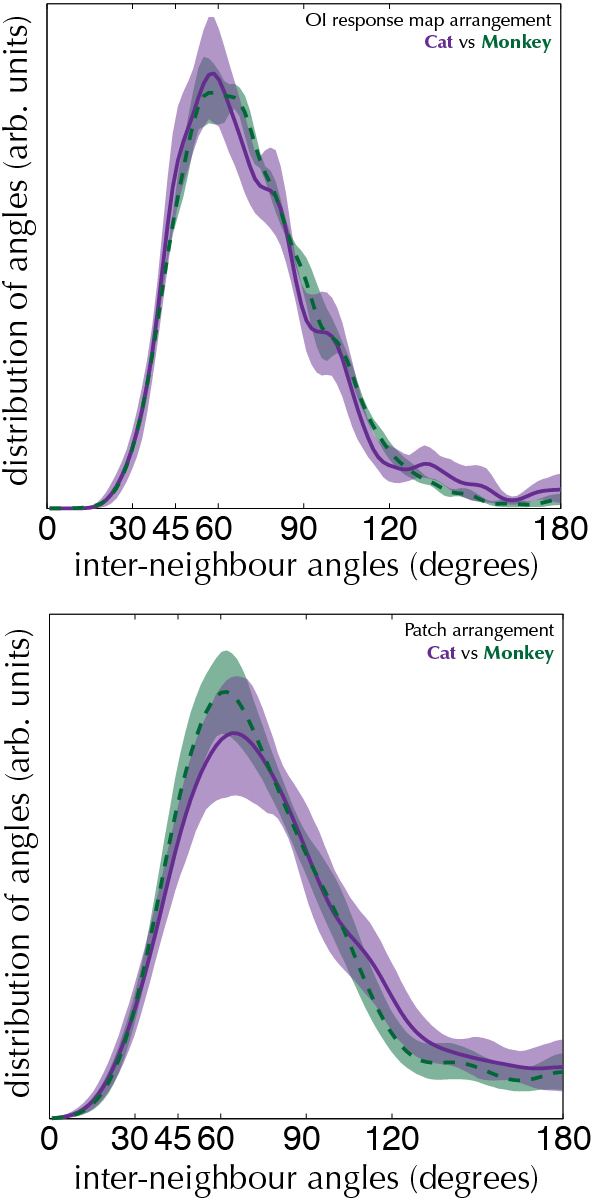The design of visual cortex
Comparisons between structure and function
10th June, 2010
A striking similarity

A striking similarity

How consistent is the design of visual cortex between species? To what extent is the arrangement of function in visual cortex reflected in its anatomy? We found the answers to these questions hinted that intra-cortical connections play a strong role in determining the layout of cortical function.
The clustered arrangement formed collectively by axonal projections of pyramidal cells in the superficial layers of mammalian cortex has drawn the attention of neuroanatomists and modellers for many years. Injections of neural tracers reveal the tendency for populations of labelled cells to collectively form patches of labelled somata and excitatory axonal terminals, separated by regions of light or absent label, and covering several millimetres within a cortical area (Lund et al. 2003). The individual pyramidal cell axonal arbors that form the assumed substrate for these patches can span at least 4 mm in cat area 17 (Gilbert and Wiesel 1983) and at least 2 mm in macaque monkey area V1 (McGuire et al. 1991). Known as the superficial patch system, the quasi-periodic nature of the labelling patterns in primary visual cortex is evocative of the petals of a flower, inspiring the alternate moniker of the daisy architecture (Douglas and Martin 2004).
It is unclear what general principle of cortical processing is subserved by the patterned excitatory projections of the patch system. Where comparisons between patches and cortical function have been made, a consistent — albeit weak — correlation between the locations of labelled patches and markers for cortical function has emerged. If connections between similar functional domains is truly the principle underlying the anatomy of the patch system, then the average spatial arrangement of the patch system and of functional maps should be identical. Previous analyses of these spatial arrangements have been restricted to comparisons made in single animals, and their accuracy has been limited by the precision of alignment between functional maps and tissue processed for histology. We introduced a technique that does not rely on such alignment, but directly measures the statistical structure inherent in the arrangement of labelled patches and of cortical responses.
We applied the statistical theory of shape to measurements of the spatial configuration of function and anatomy in neocortex. This allowed us to examine the superficial patch system and the arrangement of active regions in OI response maps for evidence of lattice structure, pooled across several experimental animals. Our measurements revealed a distinctive, non-random arrangement in the way patches and active regions spread across the surface of primary visual cortex — both systems exhibited evidence for noisy hexagonal structure, but not square lattice structure. More importantly, the configuration of labelled patches was strikingly similar to that of the cortical response to drifting grating stimuli. We also found that the “design” of area 17 is remarkably conserved between cat and macaque monkey, despite an almost two-fold difference in density of patches and active regions between the two species.
We propose that the superficial patch system is an anatomical substrate encoding a statistical expectation of the cortical response. This fact becomes easily observable for a particular class of stimuli; specifically, stimuli that require encoding of identical stimulus parameters over the full extent of the visual field. The cortical response to these stimuli consists of active regions that collectively encode identical functional parameters. We call these evoked cortical states self-consistent states, since each active region encodes parameters of the stimulus that are consistent with all other concurrently active regions across the visual cortex. Comparisons between the patch system and the cortical response made using aggregate maps of function, such as angle maps of orientation preference, may obscure the relationship between self-consistent states and the patch system. Here we directly searched for — and found — evidence linking the patch system and self-consistent cortical states, by comparing their respective spatial arrangements.
Publications
This work was published in Cerebral Cortex: DR Muir, NMA Da Costa, CC Girardin, S Naaman, DB Omer, E Ruesch, A Grinvald, RJ Douglas. 2011. Embedding of cortical representations by the superficial patch system. Cerebral Cortex 21 10:2244–2260. DOI: 10.1093/cercor/bhq290.
Funding
This work was supported by the European Commission [FP6 2005-015803 DAISY to DRM, ER, AG and RJD]; and the John Crampton Travelling Scholarship to DRM.